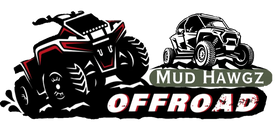ATV / UTV Quad Bike Wheel Offset Guide
Understanding wheel offsets is essential when choosing aftermarket wheels for your ATV or UTV. Getting the wrong offset can affect handling, cause clearance issues, or prevent proper fitment. This comprehensive guide will help you select the perfect wheels for your quad bike.
What is ATV Wheel Offset?
ATV wheel offset determines where your wheel sits in relation to your vehicle. Every rim has an offset consisting of two measurements that show how the wheel is positioned around the mounting hub.
The offset uses a "+" system with two numbers:
- First number: Distance (in inches) from the inside lip of the rim to the center hub
- Second number: Distance (in inches) from the hub to the outside lip
Example: A wheel with 4+3 offset means:
- 4 inches from inside lip to hub center
- 3 inches from hub center to outside lip
- Total rim width = 7 inches (4+3)
Positive vs Negative Offset Explained
Positive Offset
- More rim behind the hub, less rim in front
- First number is larger than the second number
- Examples: 4+2, 5+2, 4+3, 5+3
- Wheels sit closer to the vehicle
- Most common for standard applications
Negative Offset
- Less rim behind the hub, more rim in front
- First number is smaller than the second number
- Examples: 2+5, 3+4, 3+5
- Wheels sit further from the vehicle
- Creates wider stance and aggressive look
Choosing Correct Offsets by Suspension Type
For STRAIGHT REAR AXLE Models
FRONT Wheels:
- Requires positive offset
- Choose: 4+2, 4+3, or 5+2
- First number larger than second
REAR Wheels:
- Requires negative offset
- Choose: 2+5, 3+5, or 3+4
- First number smaller than second
For INDEPENDENT REAR SUSPENSION Models
You have two options:
Option 1: Same Width Rims (Front & Rear)
- Use identical positive offset for front and rear
- Examples: 5+2, 4+3, or 6+1
- Can run same tire sizes or different widths on same rims
- Simpler ordering process
Option 2: Different Width Rims
- Front: Narrower rims with positive offset (4+2 or 4+3)
- Rear: Wider rims with positive offset (4+4 or 5+3)
- Mimics factory setup with different front/rear widths
Common Offset Examples
5+2 Offset (Most Standard)
- Most popular ATV wheel offset
- Rim face sits closer to exposed edge
- Majority of wheel/tire sits underneath ATV
- Standard for: Front wheels on utility ATVs/UTVs
- Also used: Rear wheels on independent suspension models
2+5 Offset (Deep Dish)
- "Negative offset" or "deep dish" wheels
- Rim face recessed about 5 inches from outside edge
- Primary use: Rear wheels on straight axle ATVs
- Alternative use: Front and rear on IRS models for wider stance
- Result: About 3 inches wider per side than 5+2 offset
Using Offsets to Widen Your Stance
Wide Stance Applications
- Only available for Independent Rear Suspension models
- Popular on: UTVs for increased stability
- Also used on: ATVs for aggressive, extreme appearance
Achieving Wider Stance
Method 1: Negative offset wheels
- Choose: 2+5, 3+4, or 3+5
- Wheels extend further from vehicle
Method 2: Wheel spacers
- Alternative to changing offset
- Can be combined with standard offsets
Important Fitment Considerations
Before Ordering Wheels:
Check Bolt Pattern:
- Measure both front and rear - they may differ
- Some ATV models use different patterns front/back
- Essential for proper wheel mounting
Verify Suspension Type:
- Straight rear axle vs Independent rear suspension
- Determines which offset combinations you can use
- Affects wheel width options
Consider Your Goals:
- Standard replacement: Match factory offset specs
- Wider stance: Choose negative offsets (IRS only)
- Performance: Consider handling vs stability trade-offs
Offset Impact on Performance
Positive Offset Effects:
- Wheels sit closer to vehicle center
- Better for narrow trail riding
- Reduced stress on wheel bearings
- Improved fuel economy
- May limit ground clearance
Negative Offset Effects:
- Wider vehicle stance
- Increased stability at speed
- More aggressive appearance
- Higher stress on suspension components
- May affect turning radius
Popular Offset Combinations by Use
Trail Riding:
- Front: 5+2 or 4+3
- Rear: 5+2 (IRS) or 2+5 (straight axle)
Mud Riding:
- Front: 4+3 or 5+2
- Rear: 2+5 for wider stance and stability
Racing/Performance:
- Depends on: Track width regulations
- Consider: Weight distribution and handling balance
Work/Utility:
- Standard: 5+2 front and rear (IRS)
- Prioritize: Durability and parts availability
Measuring Your Current Offset
Tools Needed:
- Tape measure
- Straight edge or ruler
Steps:
- Remove wheel from vehicle
- Lay wheel face-down on flat surface
- Measure from inside lip to hub mounting surface
- Measure from hub mounting surface to outside lip
- Record as first number + second number
Professional Installation Tips
- Always verify bolt pattern before ordering
- Check clearance for suspension components and bodywork
- Consider tire size changes with new offsets
- Test fit before final installation when possible
Need Help Choosing?
Selecting the right wheel offset can be complex. Our expert team can help you choose the perfect combination for your specific ATV model and riding style. Contact us with:
- Your ATV make, model, and year
- Current wheel specifications
- Intended use (trail, mud, racing, etc.)
- Desired stance (stock, slightly wider, maximum width)
We'll recommend the ideal offset combination to achieve your goals while maintaining proper fitment and performance.
